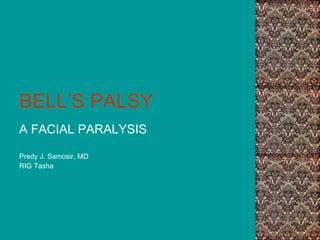
BELL’S PALSY.ppt.pptx
- 1. BELL’S PALSY A FACIAL PARALYSIS Predy J. Samosir, MD RIG Tasha
- 2. DEFINITION ● Bell's palsy is a paralysis or weakness of the muscles on one side of your face. Damage to the facial nerve that controls muscles on one side of the face causes that side of your face to droop. The nerve damage may also affect your sense of taste and how you make tears and saliva. This condition comes on suddenly, often overnight, and usually gets better on its own within a few weeks.
- 3. ● Bell's palsy is not the result of a stroke or a transient ischemic attack (TIA). While stroke and TIA can cause facial paralysis, there is no link between Bell's palsy and either of these conditions. But sudden weakness that occurs on one side of your face should be checked by a doctor right away to rule out these more serious causes.
- 4. CAUSES ● The cause of Bell's palsy is not clear. Most cases are thought to be caused by the herpes virus that causes cold sore. ● In most cases of Bell's palsy, the nerve that controls muscles on one side of the face is damaged by inflammation. ● Many health problems can cause weakness or paralysis of the face. If a specific reason cannot be found for the weakness, the condition is called Bell's palsy.
- 5. SYMPTOMS ● Symptoms of Bell's palsy include: ● Sudden weakness or paralysis on one side of your face that causes it to droop. This is the main symptom. It may make it hard for you to close your eye on that side of your face. ● Drooling. ● Eye problems, such as excessive tearing or a dry eye. ● Loss of ability to taste. ● Pain in or behind your ear. ● Numbness in the affected side of your face. ● Increased sensitivity to sound.
- 6. HOW TO DIAGNOSE ● Your doctor may diagnose Bell's palsy by asking you questions, such as about how your symptoms developed. He or she will also give you a physical and neurological exam to check facial nerve function. ● If the cause of your symptoms is not clear, you may need other tests, such as blood tests, an MRI, or a CT scan.
- 7. HOME CARE ● Facial exercises. As the nerve in your face begins to work again, doing simple exercises-such as tightening and relaxing your facial muscles-may make those muscles stronger and help you recover more quickly. Massaging your forehead, cheeks, and lips with oil or cream may also help.
- 8. Eye care. ● If you can't blink or close your eye fully, your eye may become dry. A dry eye can lead to sores and serious vision problems. To help protect the eye and keep it moist: ● Use your finger to close and open your eyelid often throughout the day. ● Use eye drops ("artificial tears") or ointment. Those that contain methylcellulose are a good choice and don't require a prescription. You may want to use drops during the day and ointment at night while you sleep. Ask your doctor how often to use the drops. ● Wear an eye patch while you sleep, and wear glasses or goggles the rest of the time.
- 9. ● Mouth care. If you have no feeling and little saliva on one side of your tongue, food may get stuck there, leading to gum disease or tooth decay. Brush and floss your teeth often and well to help prevent these problems. To prevent swallowing problems, eat slowly and chew your food well. Eating soft, smooth foods, such as yogurt, may also help.
- 10. SOURCE ● http://www.webmd.com/brain/tc/bells-palsy-topic-overview?page=2 WebMD Medical Reference from Healthwise, February 18, 2011 © 1995-2011 Healthwise, Incorporated. Healthwise
